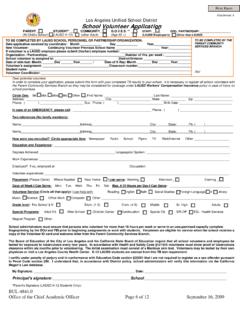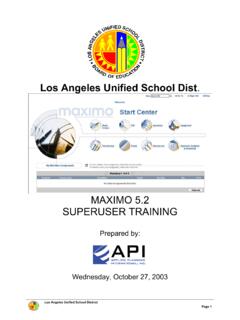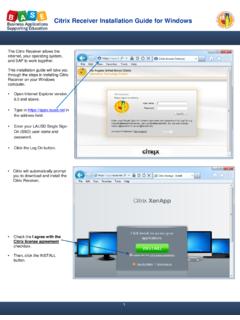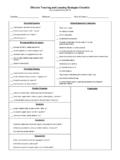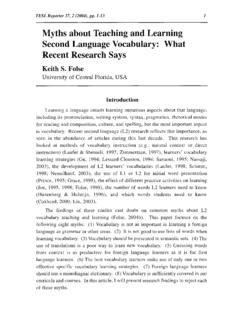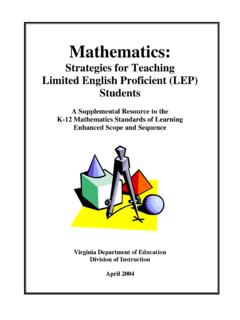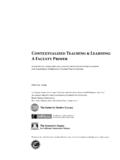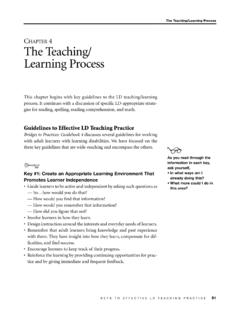Transcription of Teaching Word-Learning Strategies - Los Angeles …
1 CHAPTER 5. Teaching Word-Learning Strategies For every word known by a child who is able to apply morphology and context, an additional one to three words should be understandable. William Nagy and Richard Anderson, Vocabulary Researchers T. eaching students Word-Learning Strategies Strategies such as using context and word parts to unlock the meanings of words they don't know is tremendously important. With tens of thousands of words to learn, anything we can do to help students be- come more proficient independent word learners is an absolute neces- sity. Fortunately, we can do a lot to sharpen students' skills at learning words on their own.
2 This, as Nagy and Anderson (1994) suggest, will enable students to more than double the number of words they learn. In this chapter, I discuss five ways in which we can help students become increasingly competent at learning words on their own. These are Using Context to Unlock the Meanings of Unknown words Using Word Parts to Unlock the Meanings of Unknown words Using the Dictionary and Related Reference Tools Developing a Strategy for Dealing with Unknown words Adopting a Personal Approach to Building Their Vocabularies Before describing instruction to build students' competence in each of these important areas, I will first describe a very powerful general model for Teaching Strategies , a model that underlies all of the instructional procedures I discuss in this chapter.
3 A POWERFUL MODEL FOR Teaching Strategies . A substantial body of theory and research has supported two ap- proaches to Teaching Strategies direct explanation of Strategies and 91. 92 The Vocabulary Book transactional Strategies instruction (Sales & Graves, 2005). Direct ex- planation of Strategies has been repeatedly validated and endorsed over the past 2 decades ( , Duffy, 2002; Duffy et al., 1987; Duke & Pearson, 2002; Graves, Juel, & Graves, 2004; National Reading Panel, 2000; Pear- son, Roehler, Dole, 1992, RAND Reading Study Group, 2002;. Sweet & Snow, 2003). Direct explanation of Strategies is a very explicit, step-by-step approach.
4 Usually, carefully prepared materials specifically designed to facilitate students learning the strategy and carefully pre- planned lessons are used. A typical unit that is used to initially teach a strategy might last from several days to several weeks. Such a unit be- gins with the teacher doing the bulk of the work explaining the strat- egy, noting its importance, modeling its use, and the like. Then, gradually, the instruction is modified so that students assume primary responsi- bility for use of the strategy. The basic components of direct explanation of Strategies are listed below.
5 An explicit description of the strategy and when and how it should be used Teacher and/or student modeling of the strategy in action Collaborative use of the strategy in action Guided practice using the strategy with gradual release of respon- sibility Independent use of the strategy (Duke & Pearson, 2002, pp. 208 . 210). Following these steps is a powerful, effective, and efficient way to ini- tially teach a strategy. Used by itself, however, direct explanation may be too artificial and too separated from the ongoing activities of the classroom. Students may learn to use the strategy during the special periods set aside for strategy instruction but then fail to use it when they are reading at other times of the school day and outside of school.
6 In response to this problem, Pressley and his colleagues developed transactional Strategies instruction. It too has been validated in a num- ber of studies ( , Brown, Pressley, Van Meter, & Schuder, 1996; Pressley, 2000, 2002; Pressley, El-Dinary, et al., 1992; Reutzel, Fawson, & Smith, 2003). Like direct explanation, transactional Strategies instruction includes some direct explanation as part of the initial instruction. Com- pared to direct explanation, however, transactional Strategies instruc- tion is much less structured, and the period of direct explanation is likely to be brief.
7 Moreover, transactional Strategies instruction is introduced as part of the ongoing reading activities in the classroom when the oc- Teaching Word-Learning Strategies 93. casion arises for students to use a particular strategy. This means that the instruction cannot be preplanned and special materials to facilitate Teaching it cannot be prepared in advance. Although there is solid evi- dence that transactional instruction is effective, there is also clear evi- dence that relatively few teachers can and do learn to use transactional Strategies instruction (Pressley & El-Dinary, 1997; Pressley, 2002).
8 Be- cause it is an on-the-fly approach and not supported by a specific cur- riculum and instructional materials, teachers have found it very difficult to work transactional Strategies instruction into the school day. The approach described in this chapter, balanced Strategies instruc- tion, combines these two approaches and modifies them in several ways. Balanced Strategies instruction is initially more deliberate and carefully planned than transactional instruction but later on includes more re- view, rehearsal, integration, and constructivist activities than direct explanation.
9 Additionally, balanced Strategies instruction includes more direct attention to motivation and engagement than is often included in the other two types of Strategies instruction. Finally, in keeping with the approach to strategy instruction described by Paris, Lipson, and Wixson (1983), with balanced Strategies instruction, students are given declarative, procedural, and conditional knowledge. That is, they receive detailed knowledge about the Strategies , they learn how to actually use them, and they learn when to use them. Here are some guidelines to follow when working with balanced Strategies instruction, guidelines modified from suggestions given by Pressley, Harris, and Marks (1992).
10 In the initial planning of instruction, at the beginning of the ac- tual instruction, throughout the initial instruction, and in follow- up activities, teachers give substantial attention to motivating students to use the Strategies , particularly by highlighting the empowerment that comes when students use the Strategies on important academic tasks. Teachers fully explain and discuss with students the value of the Strategies and rationales for using them, including why Strategies aid performance and when they can be used profitably. Teachers extensively model the Strategies and provide verbal explanations and collaborative discussion of the thinking pro- cesses associated with strategy steps.


